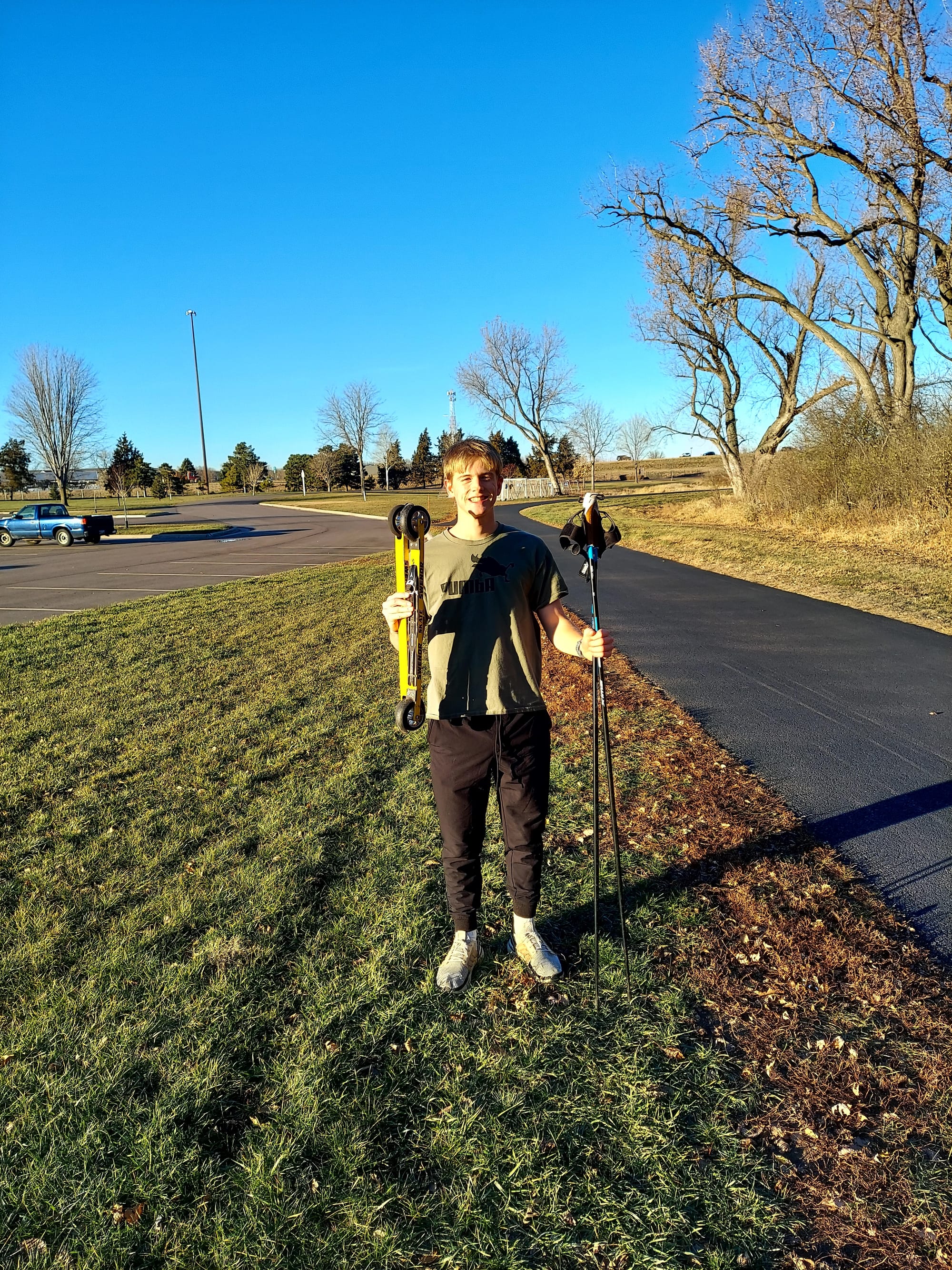Students showcase unconventional hobbies

Whether it be having a strange party trick, accruing an obscure collection or enjoying an odd food combination, everyone has one thing that makes them stand out. For some students, their notability shines through in the interesting hobbies they participate in.
Junior Grant Pederson, a business communication major with a brewing and fermentation minor, is one such student who chooses an unconventional way to pass the time. His preferred hobby is backpacking.
Pederson said the hobby is similar to extreme hiking, where people go for days at a time and carry everything on their backs. He was first introduced to the hobby by his family.
“We grew up hiking,” Pederson said. “Backpacking was the natural progression from there.”
Pederson started backpacking alone in his sophomore year when he took on the Centennial Trail, a 125-mile trek near Rapid City.

While the hiking is physically daunting, Pederson said the mental training is just as tough.
“It’s a mental challenge more than anything,” Pederson said. “It was like six days of being alone, and I just remember being so desperate to talk to people because I was just talking to myself.”
Pederson said another challenging aspect of the hobby is planning the trips.
Pederson said another challenging aspect of the hobby is planning the trips.
“You have to plan each day, how far you think you'll go, where you'll camp, where you’ll get food and water,” Pederson said. “For the Centennial, a month before I made a care package of food and sent that ahead.”
Arranging these trips requires strategy as well as planning.
“There's a lot of thought in the planning that's involved,” Pederson said. “One of the biggest things you try to do is try to get your pack as light as possible because you're carrying it with you the whole time. So that means snapping your toothbrush in half and not carrying deodorant because you just gotta embrace the smell.”
Pederson said his current goal is to someday hike Mount Whitney in California.
“My favorite thing is just the break from reality,” Pederson said. “I think it’s nice being miles away from towns and other people and just being alone, which is kind of scary to other people, but I kind of find it to be calming.”
A history and Spanish major, sophomore Jacob Paulsen’s hobby also requires intense physical fitness. He enjoys skiing without snow in a sport called roller-skiing.
Paulsen describes the hobby as cross-country skiing on wheels during the summer.
Paulsen started cross-country skiing in middle school, and over the summers he would use roller-skiing as a way to continue training. He said he recommends beginners start with cross-country skiing, as it is a safer way into the sport.
“It’s a little safer [on snow] because you don’t have brakes on roller skis and you’re on asphalt, so you can hurt yourself pretty quickly if you’re not being careful,” Paulsen said. “There is a danger with it because you go down hills and there’s smaller wheels, so if you hit cracks while going 20 miles per hour, you just slide on the asphalt. It’s not the safest thing, but that’s kind of what makes it fun.”
Despite the danger, Paulsen said the sport is a great stress relief, a good way to connect with nature and an intense workout.

“It’s a full body workout, compared to working one specific muscle when you’re weightlifting or just legs when you’re running,” Paulsen said. “It takes a lot of commitment.”
Paulsen’s favorite memory while roller-skiing is chasing a stray dog on his skis at Dunham Park until he eventually found the owner.
Sophomore Erica Carmody, an anthropology major, also trains intensely for her hobby. To pass her time, she enjoys fencing and training with other weapons.
“It’s interesting because you get a rush of adrenaline,” Carmody said. “You don’t want to get stabbed, but also, it’s more just your body moves before you do.”
Carmody first got into the hobby last January when she joined the fencing club at Augustana.
“I got drawn to it because who doesn’t want to play with swords?” Carmody said.
While the club focuses on fencing, it is also involved with other forms of weaponry.
“It’s kind of a weapons club,” Carmody said. “Any weapon you can think of we’ve probably tried to use.”

Carmody said in her time in the club, she has practiced with fencing, rondeles, daggers, short swords, long swords, great swords, spears and sickles.
“Everyone has a fantasy of wanting to go somewhere that’s not their own time or place,” Carmody said. “You can kind of do that in this sense. Where else do you see people with swords that actually know how to use them now?”
While history is a big aspect of what drew Carmody to fencing, she said the club is the main reason she decided to pursue the hobby.
"I thought ‘Oh, I have an opportunity to learn how to do something. I didn’t think I’d have this opportunity. Let’s do it.’ Because here at Augie, it’s free to show up,” Carmody said.
Her biggest goal right now is to continue learning combat techniques.
“I may know how to hold the weapon, but I don’t really have any techniques in place,” Carmody said. “I can hit you, but they’re not techniques. It’s freestyle.”
Junior Andrew Berntson, a computer science and biology major, has also found a place on campus for his hobby. He raises and breeds shrimp in his dorm room.
“My first instinct was to over-engineer and overthink everything, but that’s not how it really is,” Berntson said. “You just put water in a tank and put some food in there every once in a while. You don’t need anything fancy. It’s super easy.”
Berntson first got the shrimp because he was looking for an unconventional pet.
“I was just fascinated with having a little bit of the world and nature in my room, and I think fish can be kind of boring,” Berntson said. “I was looking for invertebrates and stuff I could keep, and the shrimp looked pretty.”
Berntson said he didn’t expect to become a breeder at first, but now he sells the shrimp for $1.50-2.00 each.

“I bought a couple from a store and took care of them and then they started having babies,” Berntson said. “I was just looking at the tank, and I saw like seven or eight baby shrimp on the glass, and I was like ‘Whoa, I feel like a parent.’ I was so happy.”
Berntson said the hobby is good for self-care and mental health.
“I think it’s super satisfying to watch the little shrimps walking around and just doing their thing,” Berntson said. “They’re just so pretty. It’s like a little community. Taking care of them makes me feel more fulfilled.”
Berntson currently raises the Blue Velvet variety of Neocaridina shrimp, but he is looking to expand his collection in the future.
“There's one particular shrimp I really want to get,” Berntson said. “It's a saltwater shrimp that's super different from the ones I have now. It's called a Peacock Mantis Shrimp, and it looks like an alien and it punches fish to death. One day, I'm going to get one of those.”
Junior Randi Eggum, a BFA art major, has also turned her hobby into a business. What started as a small pastime has turned into a large part of her income. Her hobby involves making gnomes out of clay.
Eggum first took up this hobby through the Chapel in the Hills, a traditional stave church. Eggum had been volunteering there since middle school and was approached by her boss, who asked her if she wanted to make something to be sold in the gift shop.
“My family is Norwegian, and we’re very in tune to our heritage and everything,” Eggum said. “And there was always the legend of nisse men. So, traditionally a nisse man would have been a small fairy creature that would have lived in people’s homes.”
Eggum said the myth is that the gnomes lived in houses to help with work and chores. However, if someone disturbed them or harmed their work, they would kill that person’s livestock, set stuff on fire or retaliate in some other way.
“They were either really great or really bad, and there was no in-between,” Eggum said. “I kind of grew up with that legend. I’ve messed around with clay since I was a child and made little things, and so I just started making nisse men when my boss asked for products to sell.”
Eggum sells her 1-inch tall gnomes for $5.
“It’s so hard for families to afford to go on vacation, let alone buy big souvenirs,” Eggum said. “So something as small as a tiny handmade trinket often is just what they need to remember a place.”
Since she started making her creations, Eggum said she has sold thousands. She now has expanded to selling larger gnomes as well as houses for them. She also travels to fairs and festivals to sell her products.
“I never expected it to go this far, let alone help my savings so much in the process,” Eggum said. “I don’t have the time during the school year to have a full time job. So, I’ve truly been blessed with the opportunity to have my work somewhere that is just progressively being sold. It’s like a dream scenario.”



